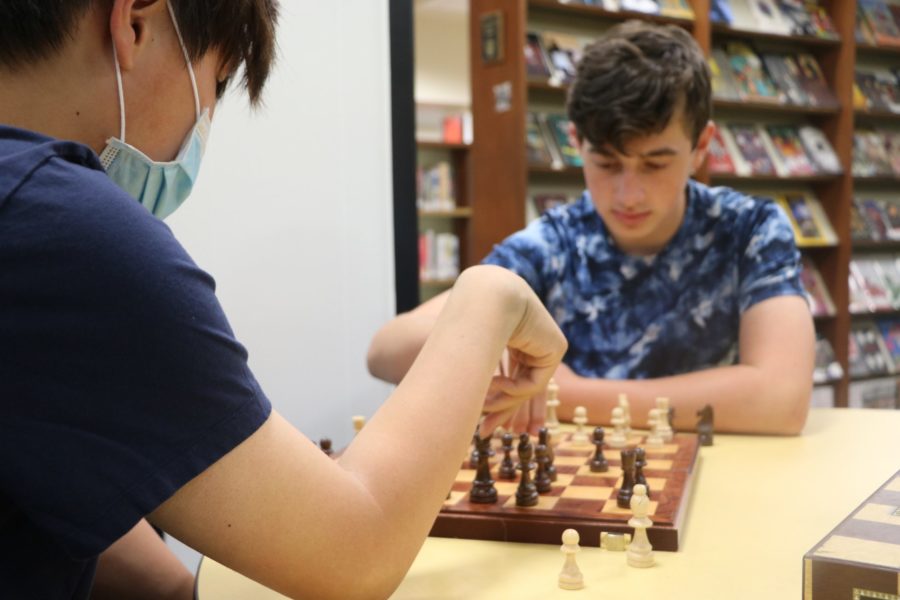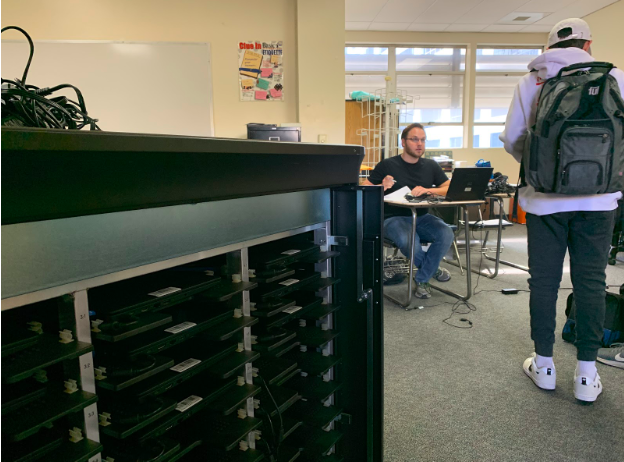Ava Seccuro co-editor-in-chief
The Board of Education unanimously approved a motion to purchase new laptops to equip everyone, not just sophomores and seniors, with a district issued computer as stated in the district’s technology rollout plan.
The decision to purchase new Dell laptops, chargers and cases at a cost of $655 per unit combined with an additional purchase of 17 laptop carts, which was made around a week and a half ago, totals to approximately $715,000 according to the final quote sent to Assistant Superintendent for Business Services Wade Roach from technology solutions provider CDW-G.
This decision, however, was not easily reached. The board called a special board meeting for Nov. 5 specifically to discuss the pros and cons and to work toward a motion to either approve or deny, due in part to the many facets of the issue.
Board Member Tristen Walker-Shuman objected to the first mention of the authorization of the purchase order on the Oct. 15 board meeting because the initial purchase of the laptops and technology for the district was not bought in “totality,” leading elementary grades to have tech, but ninth and eleventh graders to have a lack thereof, she said. Additionally, she said that the cost specifically of the laptops along with the carts, is “exorbitant” and wanted to discuss a more fiscally responsible approach before approving the purchase order.
As she has held this same opinion since the Oct. 15 board meeting, Principal Mark Mead acknowledges the validity of Walker-Shuman’s concern; however, he believes that in order to have teachers successfully collaborate with each other to facilitate the “one to one ecosystem” that the district has been planning since at least last year, they must move ahead with the purchase.
Conceptual Concerns
The primary goal for Assistant Superintendent of Education Services Dustin Seemann is to fulfill the 1:1 technology plan that the district had initially pitched four years ago. It’s a difficult decision for any “leader” to make, he said, regarding the pros and cons of the situation.
“We have seen how educational technology has provided differentiated instruction to our students from TK-8th grade over the last 2-3 years. The collaboration that educational technology provides our students is invaluable,” Seemann said in an email. “The cons are that educational technology is very expensive to purchase and to maintain. The issue we face currently is that we would need to change the management system that is currently supporting the Dell computers that are deployed today.”
The goals the district has set this year in terms of finishing the rollout have in previous years stayed within the bounds of the technology department. However, while the district is trying to get everyone on a 1:1 basis, the problem Seemann described is a direct product of, according to Superintendent Dr. Michael Bregy, the fact that “we have no roadmap.”
“There was this kind of district wide pivot, but the timeline essentially stayed the same. I think [this] was a challenging timeline,” Mead said. “What really needs to happen is strategic professional development, having the right tech coaches, which I believe we have, [and then], are departments starting to collaborate. What [does] collaboration look like? How do we make each other better?
Given this, Mead conducted an anonymous survey with 75 teachers present at the Oct. 23 professional development meeting. This pupil free day had an emphasis on technology training, Mead said, and his goal was to try to assimilate Google Classroom into instruction. He found that on a scale of one to four, four being “most successful” or “most satisfied,” the majority of responses out of a total of 64 he received were three’s and four’s.
Thus, Mead came to the conclusion that although the “infrastructure” of technological hardware is important in making this rollout successful, what’s equally as important is giving teachers the tools via professional development to be able to use the technology to their fullest extent.
Walker-Shuman, at the Nov. 5 special board meeting, had a very similar sentiment.
“Where does the requirement come into play that all of the teachers are required to use technology in a certain way? Because that’s not specifically in the contract,” she said. “That is equally as important to me as the purchase of the computer[s].”
District Concerns
Mead said that in a “perfect world,” the high school would have an environment where going to class without a laptop would be “laughable.” But for now, that is not the case, chiefly due to the issue of classes with mixed grade levels.
Classes that have either both ninth and tenth graders, eleventh and twelve graders, or some other mixture, mean that since tenth and twelve graders were the only ones given computers last year, teachers who have classes with students of mixed grade levels cannot implement the 1:1 technology plan into their instruction.
The solution, ostensibly, would be to use the laptops in the carts that are in some of the classrooms. However, there are problems with these carts: namely, the computers are out of date because their processors are from 2011; there are not enough slots and laptops in the carts for an average class as the carts only have 30 slots, while there’s an average of 32 students per class; and according to anecdotal evidence from Mead, laptops in the carts do not last as long, thus they are not cost effective, since students do not have a personal incentive to keep the device in good condition.
“In the two years that I’ve been here, the only issues within state testing have always been at the high school due to the fact of trying to get those carts to work,” Seemann said after reflecting on his personal experience administering the SBAC testing with cart laptops. “I am confident that only seven to 12 of [these laptops] are deployable.”
Although Mead said he’d be “totally happy” with a strategic cart plan, he recognizes that it’s not the best solution and that the main goal is to shift to a total 1:1 technology structure.
Walker-Shuman wants just the same: her two requirements to approve the purchase order were that the computers had to be of adequate use and of a reasonable price. She said that although she thinks everyone on the board wants to make the best decision fiscally, they differ in terms of how the plan should be executed.
The plan as of now, curated and confirmed by Seemann at the special board meeting, is that
next year’s incoming third grade will be given a Chromebook off the bat. Chromebooks are $350, and have a three year shelf life; Chromebooks would be replaced upon entry to the sixth grade and again upon entry to the ninth grade.
The discrepancy between laptop models from elementary and middle school to the high school level, however, gave the board a moment of pause before initially approving the purchase order. Currently, the laptops that the third graders have would ostensibly be given to the ninth graders this year, but are “considerably different” than those of the tenth and twelve graders, Board President Noah Margo said. The elementary school laptops have a smaller screen and a slower processor, according to Information Technology Specialist Joshua Sankman.
For the laptops then that the eleventh graders still need, Mead is planning to take the computers from the tenth graders and give them to the eleventh graders this week. The Dell representative, Wendy Holmes, who was present at the special board meeting said that this whole process should begin the week of Nov. 5 in order to “get everybody ready for next year and ready to go by the end of February,” Mead said.
Seemann is on board, but said that he needs a “grace period” until fall of 2020 to get things moving.
“We want to be able to say that we, over the next six months that between now, the start of this conversation, to the end of the school year into the summer for the tech team will have the time to be able to vet out that new management process and then also be able to get us some Chromebooks for us to be able to utilize,” he said.
Fiscal Concerns
The second part of the approval motion to purchase the laptops was that before the actual purchase, the board would try to negotiate a better price from the vendor. The district, however, is bound by a non-compete contract with Dell until January 2021. This means that the district cannot search for bids outside of the current realm until the contract is up or until the district figures out a way to sever the contract, which effectively hinders the opportunity to get better prices for hardware.
Another concern, especially for Walker-Shuman, is that included in the quote is an additional 17 carts which cost nearly $30,000 each. Taking into consideration the possibility that some carts and laptops are sitting outdated and unused, before paying, she said she’d like to think about recycling the old laptops to the district’s fiscal benefit.
“The costs, the line item cost for the adapter, for the sleeve, and for the carts…I think these are exorbitant. What is the purpose of buying 17 carts for $30,000,” she said. “The intent is for kids to take these devices home, so can laptops in the carts be repurposed and can we surplus them?”
Moreover, she foresees even more potential for saving the district money.
“Based on the quotes that I’ve seen, conceivably we could save $250,000 by buying new devices for the third through fifth graders instead of the high school students,” she said. “And that would also net us 60 additional computers for the middle school, which they’ve said they needed.”
These questions lead directly to a different topic of discussion during the meeting: how the district plans to pay for this purchase in the first place. According to Board Vice President Isabel Hacker, former Director of Technology Bernadette Lucas told her that the general funds are supposed to pay for these remaining costs in the technology plan. However, the board is using Measure BH instead.
“The District currently has two bonds. Measure E was passed in 2008 for the amount of $334,000,000. As of today, $114M is remaining, all of which has been allocated for BHHS and El Rodeo modernization. Measure BH is for $385,000,000 and was passed in 2018. Approximately $13,600,000 [is] currently allocated in Measure BH for Technology,” Roach said in an email on Nov. 7.
Walker-Shuman, who “co-chaired” the Measure BH bond measure process, said that even though this is what is happening, Measure BH funds were not intended to pay for technology at this point in time because 2019 is not yet the five-year or 10-year mark of fund replenishment.
“The money that was earmarked in that bond for technology was supposed to be refreshed at five years and 10 years. So we’re not there yet,” Walker-Shuman said. “This $800,000 is coming out of that bond, which means that we have $800,000 less to finish our construction projects, which for me is very concerning.”
Roach stands by the fact that both Measure E and Measure BH can and are being used for both technology and construction, but said that there is a way, although complicated, to circumvent the enumerated bond rules.
“The initial Tech Plan for 1:1 rollout was planned to come out of Measure E. Measure E has a technology component that has been overspent. Measure BH has a technology component. If we restructure the kind of devices that we use on Measure BH, you could save enough money to take some of those savings and use on construction projects,” Roach said. “There’s a way to make this work, but it will take some gymnastics.”
Despite this dispute, Roach said that at this “late hour” he doesn’t think that the district will be able to negotiate a better price for the computers, especially using only one vendor. He suggested that the district do some more searching on their own, but that if they chose that route, they would not be able to purchase the computers — even if it was for a lower price — before January 1 as planned.
Some aspects of this plan are still subject to change, but for now, this is what the district will be doing moving forward with the technology plan.
To counteract past mistakes, Margo keeps a particular stance on technology decisions in the coming future.
“Once again, the technology program has backed us into a corner where we have to vote in the 11th hour and we are going to be very vigilant and wary with the future technology programs when they come to us because this will not happen again,” he said.
Categories:
District motions to approve new laptops, plans next stages of technology rollout
November 19, 2019
Students enter the technology office to ask Information Technology Specialist Josh Sankman questions regarding their district issued laptops or emails.
0
Donate to Highlights
$125
$1000
Contributed
Our Goal
Your donation will support the student journalists of Beverly Hills High School. Your contribution will allow us to purchase equipment and cover our annual website hosting costs.
More to Discover





























